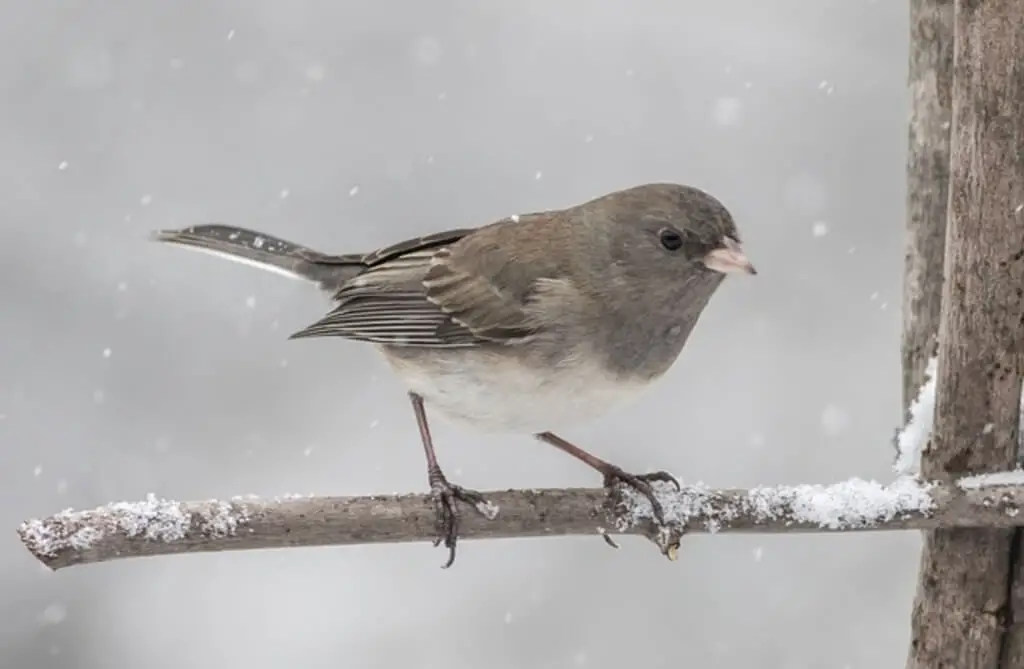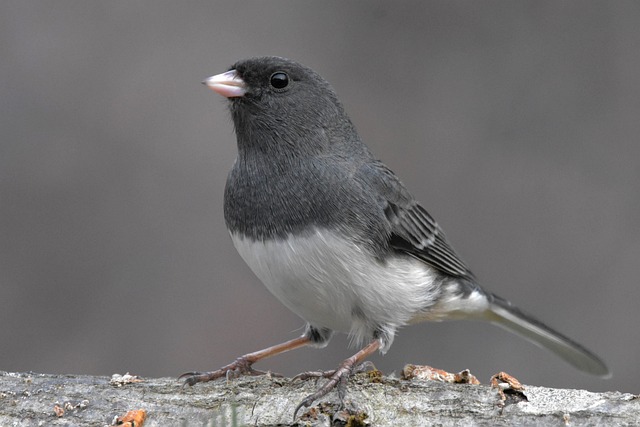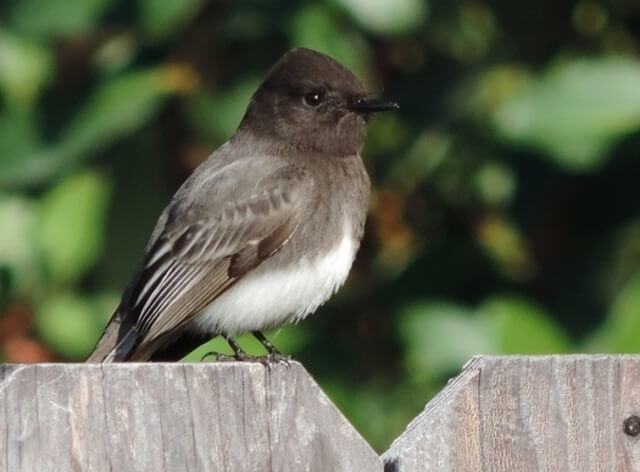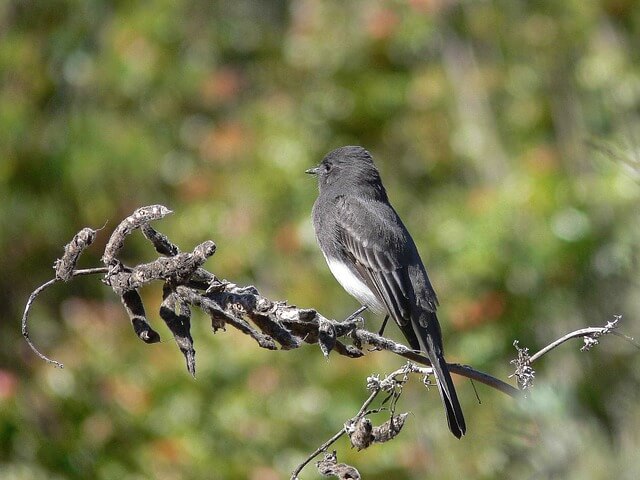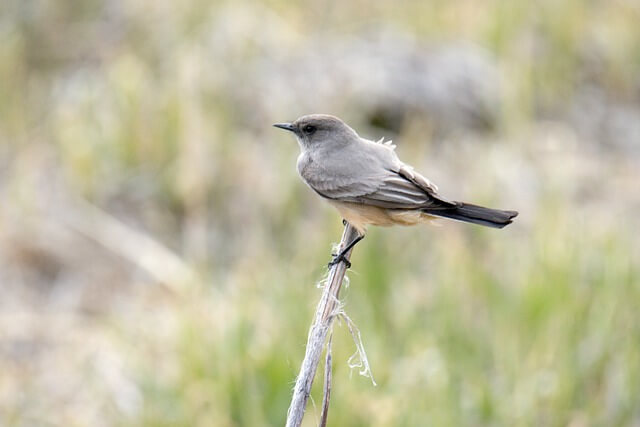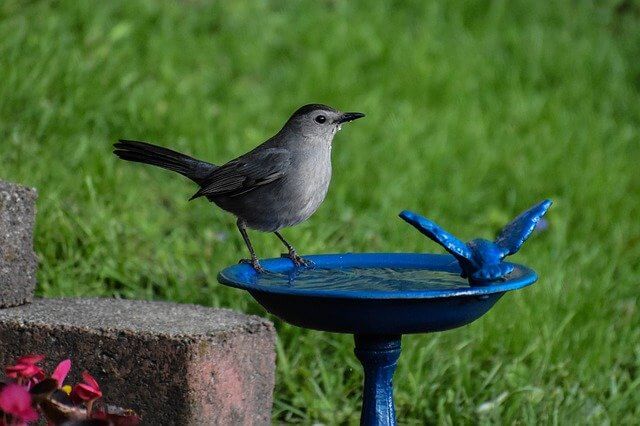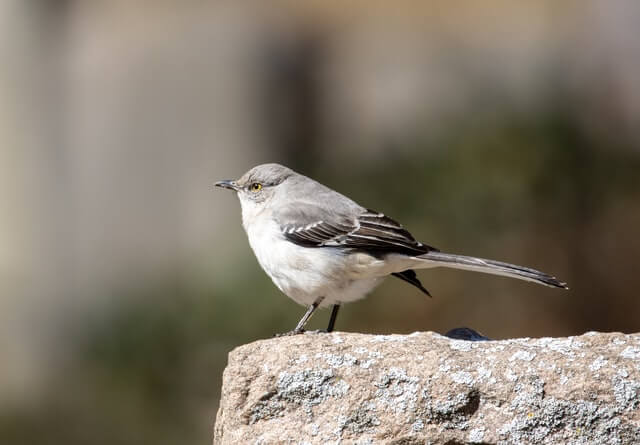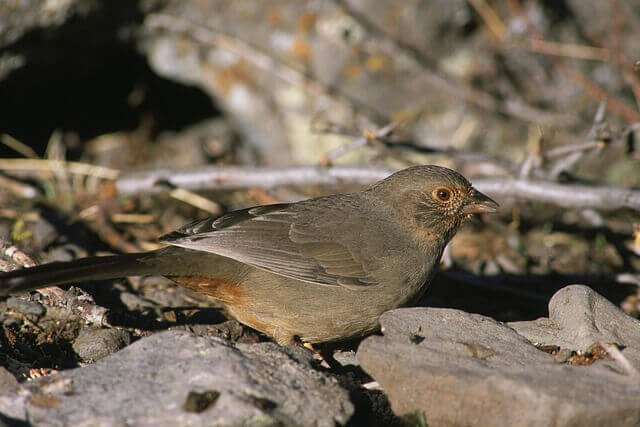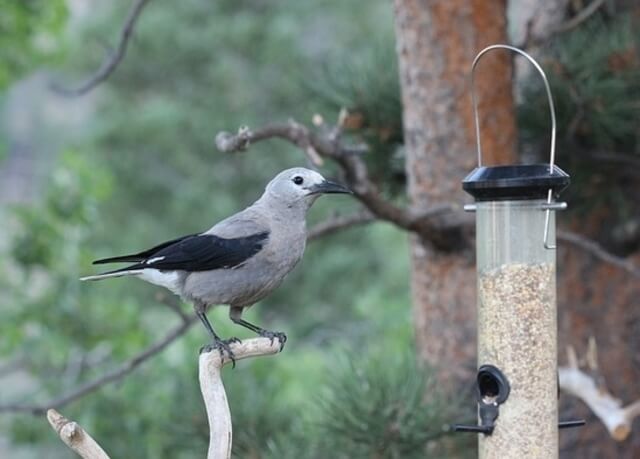In the Northern Hemisphere, juncos are a common winter bird. They are typically seen during their breeding season from March to July and then again in the fall. During migration, they can be found anywhere from southern Canada to Central America.
There are many birds that have a similar appearance to the Junco. In this article, we will look at 8 different species of bird that may be mistaken for Juncos in North America.
Table of Contents
Dark-eyed Junco (Overview)
- Scientific Name: Junco hyemalis
- Family: Emberizidae
- Size: Approximately 5-6 inches (12.7-15.2 cm) in length
- Weight: Typically 0.6-1.1 ounces (17-31 grams)
- Wingspan: About 7.5-9 inches (19-23 cm)
- Coloration: Dark-eyed Juncos exhibit considerable color variation, but they often have dark gray to black heads, backs, and tails, with white or grayish underparts. Some regional variations display different plumage colors.
- Range: These sparrows are widespread in North America, with different subspecies found across various regions.
- Habitat: Dark-eyed Juncos can adapt to a range of habitats, including forests, woodlands, parks, and suburban areas. They often forage on the ground.
- Diet: Their diet primarily consists of seeds, insects, and small invertebrates.
- Behavior: Dark-eyed Juncos are known for their ground-feeding behavior and frequent visits to bird feeders, especially in winter.
- Migration: Some populations of Dark-eyed Juncos are migratory, with individuals moving to different regions during the breeding and non-breeding seasons.
- Song: They produce musical trilling songs, and their vocalizations can vary among different subspecies.
- Conservation Status: Dark-eyed Juncos are not currently considered a species of conservation concern and are relatively common throughout their range.
Dark-eyed Juncos are small, adaptable sparrows known for their distinctive plumage and ground-feeding habits. They are a familiar sight in many North American regions, especially during the colder months when they visit backyard feeders in search of food.
Birds that look like Juncos
Eastern Phoebe
| Length | Weight | Wingspan |
|---|---|---|
| 4.5-6.7″ in. (11.5-17 cm) | 0.6-0.7 oz. (16-21.5 g) | 9.8-11.4″ in. (25-29 cm) |
The Eastern Phoebe is a delightful, small songbird that is often found in close proximity to water sources. Distinguished by its predominantly brownish-gray plumage and white underparts, the Eastern Phoebe boasts a longer, thinner bill than the Junco. In contrast, the Dark-eyed Junco is characterized by its lighter gray coloring, slightly larger size, and short, thick, pink seed-cracking bill.
The Eastern Phoebe is known to thrive in habitats that feature open water, including ponds, marshes, and wet meadows, as well as along shorelines, creeks, and streams. In contrast, the Dark-eyed Junco prefers heavily forested areas, particularly coniferous forests.
Black Phoebe
| Length | Weight | Wingspan |
|---|---|---|
| 6.1-7.08″ in. (15.5-18 cm) | 0.53-0.78 oz. (15-22 g) | 10.4-11.02″ in. (26.5-28 cm) |
The Black Phoebe is sometimes mistaken for the Junco due to its similar size and shape. However, a closer look reveals distinct differences between the two birds. For instance, while the Black Phoebe has a charcoal gray upper body and chest, a slightly larger head, and a slim, long black bill, the Junco boasts a slate-gray upper body, white belly, and a short, thick pink seed-cracking bill.
Black Phoebes are commonly found in wetland areas that contain vegetation such as grasses, shrubs, and other plants that grow near water sources or at the edge of streams and lakes. In contrast, Dark-eyed Juncos prefer more heavily forested areas, particularly coniferous forests.
Say’s Phoebe
| Length | Weight | Wingspan |
|---|---|---|
| 4.5″-7.5″ in. (11.4-19.1 cm) | 0.75 oz. (21 g) | 13.5″ in. (34 cm) |
When it comes to distinguishing between Say’s Phoebe and Dark-eyed Junco, there are some key differences to keep in mind. Say’s Phoebes are small birds with a brownish-gray upper body, reddish-brown belly, and a gray breast. They are easily recognized by their long, thin black bill, which is a distinctive feature. In contrast, the Dark-eyed Junco has a slate-gray upper body, white belly, and a short, thick pink seed-cracking bill.
Say’s Phoebes are commonly found in open areas with low vegetation, such as prairies and meadows. These environments provide ample opportunities for the birds to hunt for insects and other small prey. In contrast, Dark-eyed Juncos prefer more heavily forested areas and are typically found in coniferous forests. They are well adapted to these environments and can be easily identified by their distinct coloring and bill shape.
Gray Catbird
| Length | Weight | Wingspan |
|---|---|---|
| 8.1″-9.8″ in (20.5-25 cm) | 0.8-2.0 oz (23.2-56.5 g) | 8.5″-12″ in (21.6-30.5 cm) |
Distinguishing between catbirds and dark-eyed juncos can be challenging for many people. However, there are some key differences to keep in mind. The Gray Catbird is slightly larger than the junco and has a different coloration. While catbirds have almost entirely gray plumage, juncos have a gray upper body and a white belly. Another way to tell them apart is by looking at their bills: catbirds have long, black, thick bills, while juncos have short, thick, pink seed-cracking bills.
The Gray Catbird’s preferred habitat includes thickets, woodlands, scrubby fields, and suburban gardens with mature trees nearby. They are well adapted to these environments and can often be seen darting in and out of the underbrush. In contrast, Dark-eyed Juncos typically prefer more heavily forested areas, particularly coniferous forests, where they can easily forage for seeds and other food sources.
Northern Mockingbird
| Length | Weight | Wingspan |
|---|---|---|
| 7.9-10.4 in (20-26.5 cm) | 1.6-2.0 oz (45-58 g) | 11.8-13.8 in (30-35 cm) |
When it comes to differentiating between the Northern Mockingbird and the Dark-eyed Junco, there are some key differences to keep in mind. The Northern Mockingbird is larger than the junco and has a gray upper body with white underparts. They also have a thin black bill and distinctive yellow eyes. In contrast, the Dark-eyed Junco has black eyes and a short, thick, pink seed-cracking bill. They are also slightly smaller in overall size compared to the mockingbird.
Northern Mockingbirds are commonly found in open country environments, where they can easily forage for insects and other small prey. They are well adapted to these habitats and can often be seen perched on fences or trees, singing their melodious songs. In contrast, Dark-eyed Juncos are typically found in heavily forested habitats, particularly coniferous forests, where they can forage for seeds and other food sources.
California Towhee
| Length | Weight | Wingspan |
|---|---|---|
| 7.9-10.0 in (20-25.5 cm) | 1.3-2.4 oz (37-67 g) | 11.5 in (29.2 cm) |
The California Towhee is a North American bird that bears a striking resemblance to the Junco. However, there are some key differences to keep in mind. The California Towhee is slightly larger than the Junco and has brownish-gray plumage throughout, with an orange-brown streaked breast. In contrast, the Junco has a slate-gray upper body and a white belly and breast.
When it comes to their preferred habitats, the California Towhee tends to favor thickets or brushy areas, where it can easily forage for insects and other small prey. In contrast, the Dark-eyed Junco is commonly found in forested areas, particularly those near water sources. These environments provide ample opportunities for the Junco to forage for seeds and other food sources.
Clark’s Nutcracker
| Length | Weight | Wingspan |
|---|---|---|
| 10.2-12 in (26-30.5 cm) | 3.7-5.7 oz (106-161 g) | 24 in (61 cm) |
To distinguish between the Clark’s Nutcracker and the Dark-eyed Junco, there are some distinct differences to keep in mind. Firstly, the Clark’s Nutcracker is significantly larger than the Junco, measuring around 4 inches longer. They have a gray plumage with black wings and white wing patches, and a long, thick black bill that is well adapted for cracking open pine cones. In contrast, the Junco is a small, plump bird with a gray upper body and a white lower chest and belly. They have a short, thick pink seed-cracking bill that is well suited for their preferred diet.
The Clark’s Nutcracker is commonly found in high altitude pine forests, ranging from Canada to Northern Mexico. They are well adapted to these environments and can be easily identified by their distinctive plumage and bill shape. In contrast, the Dark-eyed Junco is typically found at lower altitudes in deciduous or mixed woodlands.
Spotted Towhee
| Length | Weight | Wingspan |
|---|---|---|
| 6.7-8.5 in (17-21.5 cm) | 1.2-1.7 oz (33-49 g) | 11.2 in (28.5 cm) |
To distinguish between the Spotted Towhee and the Dark-eyed Junco, there are some key differences to keep in mind. Firstly, Spotted Towhees are slightly larger than Juncos and have a distinctive black upper body and rust-colored flanks, with a black bill. In contrast, the Junco has a gray upper body with a white lower chest, belly, and a short, thick pink bill. While these two birds may share some similarities in size and shape, their distinct coloring sets them apart from one another.
Spotted Towhees are primarily found in forested areas east of the Rocky Mountains, where they can easily forage for insects and other small prey. They are well adapted to these environments and can often be seen darting in and out of the underbrush. In contrast, the Dark-eyed Junco can be found throughout North America in deciduous or mixed woodlands.
Frequently Asked Questions
Are Dark-eyed Juncos invasive?
The Dark-eyed junco is a small songbird that is native to North America. They are common throughout the United States and Canada, but they have also been found in Great Britain, Ireland, Sweden, and New Zealand. The population has increased dramatically over the past few decades due to habitat loss from urbanization. Many experts believe that these birds should be classified as invasive because their range has expanded so quickly and they can cause problems for other species of birds.
Do Juncos eat from bird feeders?
Juncos are common winter visitors to bird feeders. They have an appetite for sunflower seeds, and their inquisitive nature makes them easy targets for the well-placed perch. Junco’s affinity for feeding from bird feeders is not limited to those that contain seed; they will eat fruit as well, which may be offered in a suet cage or on a tray of ground up apples placed near the bottom of a tree trunk.
Do Juncos reuse their nests?
The answer is yes. Juncos build new nests each year to lay eggs and raise chicks, but they sometimes use the same nest for several years in a row. This behavior is called site fidelity, which means that an animal returns to the same place repeatedly over time. The reason that juncos return to the same nest could be because it provides good protection from predators or harsh weather conditions such as wind and rain.
Are Juncos rare?
Juncos are rare if you don’t live in the right habitat to see them. However, if you want to spot a junco, you should go for a hike through thick forests with lots of trees or visit wetland areas near water sources.
Do Juncos eat black oil sunflower seeds?
Black oil sunflower seeds are a favorite among many bird species. Some of the birds that enjoy eating these seeds include juncos, house sparrows, cardinals, and finches.
Do Juncos use birdhouses?
Juncos typically don’t use birdhouses, but they can be attracted to the warmth, and shelter that a birdhouse provides during the winter months.
Do Juncos like mealworms?
Mealworms might be one of their favorite snacks because they’re a good source of protein and fat that provides energy for the junco’s high metabolism and long flights during migration.
Do Juncos eat suet?
The answer is that they don’t. Juncos are often found in areas where suet is hung out for birds to feed on, but this doesn’t mean that they eat it. In fact, these birds will only consume a small amount of suet when it’s available and then fly away to find other food sources. Juncos typically prefer seeds and berries as their main source of food.

